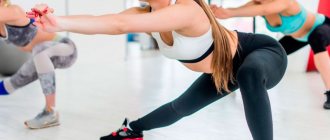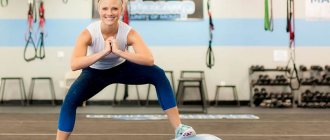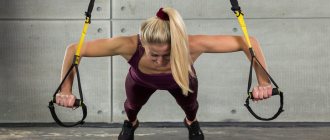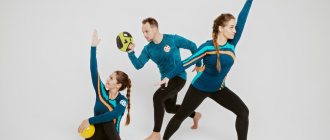Cardio training is the basis for building a beautiful, slim and toned body. There are different options for conducting classes. You can just run or use special exercise equipment in the process. Recently, cycling training or cycling has become popular. These are universal exercises - exercises performed on a special exercise bike.
At first glance, it may seem that such training is easy. This is far from true. Even for men, cycling often turns out to be a difficult activity. High-quality workouts help you lose weight, remove cellulite from problem areas and strengthen your arm/leg muscles.
What is cycling?
Cycling is a high-intensity interval training, which is carried out under the strict supervision of specially trained instructors on special block-type exercise bikes.
In order to motivate and cheer up the trainees, during the class, rousing music is turned on in the hall, images of a variety of cycling routes are displayed on a large monitor, or an interesting film is turned on (most often on a sports theme).
Cycle training is popular among a variety of categories of exercisers - here are those who want to slightly adjust their figure, those trying to lose excess weight, as well as people who simply prefer to lead an active lifestyle, thereby maintaining their health.
History of origin
For the first time, classes of this kind began to be conducted back in the 80s of the 20th century by Philip Mills, a world-famous fitness trainer who, together with his wife Jackie, developed several programs for highly effective fitness training. The essence of the technique was a competent arrangement of work on an exercise bike with a variety of gymnastic and choreographic movements.
Following him, in the 90s, American cyclist John Goldberg, who was also a fitness enthusiast, designed a stationary bicycle for himself, which was somewhat different from a regular exercise bike, but ideal for active sports at home. In addition, Goldberg also prepared a special training program that was not limited to simple pedaling - they almost completely simulated a real bicycle race, during which all muscle groups were involved.
Despite the fact that cycling is a relatively young trend in fitness, in a fairly short time it has managed to gain a lot of fans, thanks to which cycling training is now carried out in sports centers throughout the country.
The benefits of cycling training
Most often, physical activity is seen as a way to quickly lose excess weight and form a beautiful, slender figure. Cycling undoubtedly helps effectively in solving these problems. But besides everything else, cycling training has other benefits:
- By regularly doing cycling, you are unlikely to achieve a rapid decrease in total body weight. The fact is that cycling helps tone muscle tissue, which, in turn, causes an increase in muscle mass. But don’t be afraid that you will look like a pumped-up self-taught bodybuilder - the muscles simply strengthen, become denser, but practically do not increase in volume. Result: total body weight stays the same, and fat mass decreases.
- Thanks to the high intensity of training, during which the pulse literally goes off scale or remains at a critical level for a long time, all organs and tissues are actively saturated with oxygen and metabolism is accelerated. It is thanks to this that the rapid breakdown of fat cells becomes possible.
- Many skeptical critics argue that cycling helps strengthen only the muscles of the legs and buttocks, while the entire upper body remains “not for the taking”. This is actually a myth. Cycling is not just working on an exercise bike. This is a carefully thought-out workout, during which all muscles are involved including the arms, back, chest, and abdominal muscles.
- Cycling provides excellent cardio exercise. Thanks to this, the functioning of the respiratory system and heart is normalized, and blood vessels are strengthened. Result: reduced risk of heart disease, normalized blood pressure, increased overall endurance.
- Unlike other aerobic training, such as fitness, running, athletics, and strength training, cycling does not place increased stress on the joints and spine.
- There are no age restrictions, as such, for cycling training - this type of fitness can be practiced by both teenagers and older people. The main thing is to strictly follow the doctor’s recommendations and strictly follow the trainer’s instructions. It would also be a good idea to undergo a full medical examination before signing up for cycling.
- Great news for those who don’t have a lot of free time - cycle training lasts on average from 40 minutes to 1 hour. In addition, experts do not recommend more than two to three workouts per week. By the way, this time will be quite enough to get your body in order.
- Intense cycling training is carried out to the accompaniment of cheerful, incendiary music, so during classes you not only tone your muscles, getting rid of excess calories, but also receive a rapid surge of positive emotions, which significantly reduces stress levels, helps you take your mind off everyday problems and gives you a long-lasting great mood.
For those who keep a strict calorie count, let's say that in 45 minutes of intense cycling training you can easily get rid of 700 calories. Moreover, if you increase the training time to 1 hour, then at least 1000 calories will be consumed in one session.
Harm and contraindications
Like any sport, cycling also has contraindications. These include:
- Diseases of the cardiovascular system.
- High blood pressure.
- Phlebeurysm.
- Injuries and damage to the lower extremities, in particular the knee joints.
- Viral infectious diseases.
- Postoperative period.
- Pregnancy.
In addition, even if you regularly attended cycling training, but at some point, while getting ready for the next lesson, you felt weak - it is better to stay at home. The fact is that a weakened body simply cannot withstand the intense load received during cycling, and the consequences can be the most unpredictable - up to loss of consciousness.
As mentioned above, intense cycling training, even at the highest level of load, will not provide you with muscle growth, but it will make your legs slim and sculpted.
Equipment
For cycling, you can wear either a regular T-shirt and shorts, or cyclists’ equipment: a jersey and shorts with a cycling diaper. Do not wear wide trousers - they may get caught on the pedals.
Regular hard-soled sneakers or cycling shoes - the choice of shoes will depend on the level of the studio where you work out. Some clubs use trainers with contact pedals, while others use standard ones.
Water and a towel in cycling are as important as having shoes on your feet. With such a workout, you will sweat seven times, and without replenishing lost fluid, you simply will not be able to complete the workout and will harm your body.
What muscles work?
When working on an exercise bike, the muscle groups of the lower body are worked out first:
- Buttock muscles
- Quadriceps
- Hamstrings
- Muscles of the inner thighs
- Calf muscles
But the miraculous effect of cycling training on the body does not end there, since more than one centimeter of muscle tissue is left without work:
- The muscles of the lumbar region and abs contract intensely.
- The load is distributed to the back muscles.
- The chest muscles are well worked out.
The main muscle of our body is the heart. During intense cardio training, our heart receives optimal load, due to which its work in transporting blood in the body is normalized. As a result, blood circulation improves, organs are saturated with oxygen, and metabolism is normalized.
Types of cycling
When talking about types of cycling, instructors most often mean types of cycling training, which differ in intensity and technique:
- Standard easy driving. You simply pedal in a seated position, as if you were riding on a flat bike path.
- Driving at an accelerated pace. This exercise simulates a fast descent from a mountain. Performed while sitting.
- Driving with a load. To perform this technique, you need to increase the load on the exercise bike by changing the appropriate settings. Driving with a load simulates climbing a mountain.
- Driving at high speed. The main condition for this exercise is standing on an exercise bike. This technique is indispensable for clearly working out all muscle groups of the lower body.
- Driving with a load at a slow pace. This exercise is also performed while standing and simulates climbing a mountain. In this position, the load increases significantly, which ensures the optimal level of intensity of the exercise.
- Acceleration. This technique involves riding quickly while sitting or standing, but after a certain period of time it is necessary to increase the pace of pedaling: for example, 30 seconds of fast riding, then 10 seconds of work in acceleration mode.
- Resistance. This technique involves pedaling slowly, while periodically setting the maximum load. This exercise simulates climbing uphill at a high angle.
- Change of position. Riding pace – slow with a high load or fast with an optimal load. At certain time intervals (optimally 20-30 seconds), the position of the body must be changed, for example, from a “sitting” position to a “standing” position, changing the inclination of the body, etc. It is very important to maintain the pace of movement.
In addition to the above options, you can use weights (special vests and weights, dumbbells).
To optimally work out all muscle groups during cycling training, various fitness movements are used: handlebar push-ups, torso rotations, pelvic abduction.
How many calories are burned?
The dynamism of cycling training implies high rates of fat burning. And indeed it is. In one hour-long workout, a person burns up to 700 CC. By comparison, on a bike path he would lose only half that number.
In one workout you will cover about 20 km, at different speeds and intensities. Those who aim to lose weight will have to withstand such loads every time. But if you just need to increase muscle tone and tighten them a little, then a half-hour ride will be quite enough.
It’s easy to calculate how many workouts it will take to burn, for example, 5 extra pounds. One kg of fat contains 7716 kcal. If you train at maximum intensity 3 times a week, you will need 11 sessions or 1 month.
How is the training going?
In fact, it is difficult to describe how cycling training works - the fact is that training programs must change regularly. However, the course of the lesson is usually like this:
- Warm-up – 3-5 minutes.
- Riding in a standing position. In this case, the load changes periodically - 10 minutes.
- Working with the technique of changing position. In this case, the ride can simulate descents and ascents, the pace and load periodically changes - 10 minutes.
- Combined exercise. Here, in addition to the direct work on the exercise bike, the work of the torso is added - push-ups from the handlebars, the "jump" technique, pelvic abduction - 7 minutes.
- Driving with a load. Here the load can be changed periodically, the driving pace can be accelerated and slowed down from time to time - 10 minutes.
- Hitch. During the cool-down, it is best to use a standard easy ride at a comfortable pace with a minimum load of 3-5 minutes.
As we have already said, cycling training can last from 40 minutes to 1 hour. Depending on the total training time, the duration of its individual stages also changes.
How is a cycle trainer different from an exercise bike?
A standard exercise bike is a stationary device that simulates a bicycle and is equipped with numerous devices for monitoring the state of the body during exercise (pulse, blood pressure, calorie consumption, etc.)
The cycle trainer has significant differences in design - there is no such detailed screen, the design of this device is lightweight. The main task of a cycle trainer is to provide optimal load for all muscle groups.
In addition, exercise bikes are much heavier and bulkier.
At the same time, if your goal is to burn maximum calories, it is best to choose training on an exercise bike. If you want to strengthen all muscle groups, improve the functioning of the cardiovascular system, and slightly adjust your figure, give preference to group cycling training.
Rules for driving on the street
Cycling is not always just a walk. Most cities are not designed for cyclists. In the absence of bicycle paths, riding remains on the roadway and parks, or on sidewalks.
Those who drive on highways and other roadways need to know the rules of the road. This is necessary for the safety of yourself and others. And this is very important!
There are many rules, but you only need to remember a few:
- Indicate turns with a hand gesture. Straight hand to the right - you go to the right. And in the same way - to the left.
- When you drive on sidewalks, you become a threat to pedestrians. Be careful, especially if there are small children in sight who may behave unpredictably.
- If you are going to cross the road, get off your bike and drive it next to you.
There is another option - bring the bike to the park area by car and ride there. Then you can do without rules. Enjoy the ride, fresh air, nature. This is the best cardio!
Tips for Newbies
If you are planning to start cycling training in the near future, you should listen to the advice and recommendations of experienced trainers:
- Before heading to the gym, instructors advise you to reconsider your lifestyle: give up bad habits, start eating right, drinking water in the right quantities, form a healthy daily routine - get enough sleep, rest regularly.
- You should also stock up on the right set of clothes. It is recommended to buy special cycling shorts - they will help to avoid unpleasant sensations during training (the saddle on a spin bike is very hard, so beginners have difficulty getting through their first workouts without the appropriate equipment).
- It is strictly not recommended to overeat before cycling. It is best to eat one and a half to two hours before training.
- Most likely, when you come to the gym, you will meet several experienced athletes training intensively. You shouldn’t chase their results, beat yourself up, or give too much workload in the first lessons. The intensity of training should be increased gradually, based on the capabilities of your body.
- Some people mistakenly believe that light forms of fitness, such as yoga or stretching, will help them better adapt to training. In fact, over-stretching or relaxing the muscles will not have a very good effect on subsequent high-intensity exercise on the exercise bike.
If you are planning to buy a spin bike and practice cycling at home, experienced instructors strongly recommend attending several group cycling training sessions under the supervision of a professional trainer - this way you can develop your own program and avoid mistakes that can cause irreparable harm to your body.
Flaws
No matter how stunning results cycling can boast, these workouts are not available to everyone:
- There are many contraindications that absolutely cannot be ignored. Exacerbation of existing diseases, as well as serious injury, is possible.
- The need for strict adherence to the technique of performing exercises. It is important to set the parameters correctly, otherwise uncomfortable conditions are provided for the athlete, often leading to no results at all or injuries.
Interesting fact. Before training, be sure to consult with the trainer. He will help adjust the unit to the athlete’s physical characteristics and teach the correct technique for performing exercises.











